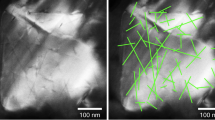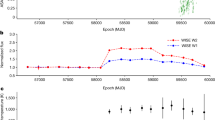Abstract
High-velocity submicrometre-sized dust particles expelled from the jovian system have been identified by dust detectors on board several spacecraft1,2. On the basis of periodicities in the dust impact rate, Jupiter's moon Io was found to be the dominant source of the streams3. The grains become positively charged within the plasma environment of Jupiter's magnetosphere, and gain energy from its co-rotational electric field4. Outside the magnetosphere, the dynamics of the grains are governed by the interaction with the interplanetary magnetic field that eventually forms the streams5. A similar process was suggested for Saturn6. Here we report the discovery by the Cassini spacecraft of bursts of high-velocity dust particles (≥ 100 km s-1) within ∼70 million kilometres of Saturn. Most of the particles detected at large distances appear to originate from the outskirts of Saturn's outermost main ring. All bursts of dust impacts detected within 150 Saturn radii are characterized by impact directions markedly different from those measured between the bursts, and they clearly coincide with the spacecraft's traversals through streams of compressed solar wind.
This is a preview of subscription content, access via your institution
Access options
Subscribe to this journal
Receive 51 print issues and online access
$199.00 per year
only $3.90 per issue
Buy this article
- Purchase on Springer Link
- Instant access to full article PDF
Prices may be subject to local taxes which are calculated during checkout




Similar content being viewed by others
References
Grün, E. et al. Discovery of jovian dust streams and interstellar grains by the Ulysses spacecraft. Nature 362, 428–430 (1993)
Grün, E. et al. Constraints from Galileo observations on the origin of jovian dust streams. Nature 381, 395–398 (1996)
Graps, A. L. et al. Io as a source of the jovian dust streams. Nature 405, 48–50 (2000)
Horányi, M., Morfill, G. & Grün, E. Mechanism for the acceleration and ejection of dust grains from Jupiter's magnetosphere. Nature 363, 144–146 (1993)
Hamilton, D. & Burns, J. Ejection of dust from Jupiter's gossamer ring. Nature 364, 695–699 (1993)
Horányi, M. Dust stream from Jupiter and Saturn. Phys. Plasmas 7, 3847–3850 (2000)
Srama, R. et al. The Cassini cosmic dust detector. Space Sci. Rev. (in the press)
Wehry, A. & Mann, I. Identification of β-meteoroids from measurements of the dust detector onboard the Ulysses spacecraft. Astron. Astrophys. 341, 296–303 (1999)
Göller, J. R. & Grün, E. Calibration of the Galileo/Ulysses dust detectors with different projectile materials and at varying impact angles. Planet. Space Sci. 37, 1197–1206 (1989)
Zook, H. et al. Solar wind magnetic field bending of Jovian dust trajectories. Science 274, 1501–1503 (1996)
Horányi, M., Morfill, G. & Grün, E. The dusty ballerina skirt of Jupiter. J. Geophys. Res. 98, 21245–21251 (1993)
Richardson, J. D. An extended plasma model for Saturn. Geophys. Res. Lett. 22, 1177–1180 (1995)
Chow, V., Mendis, D. & Rosenberg, M. Role of grain size and particle velocity distribution in secondary electron emission in space plasmas. J. Geophys. Res. B 98, 19065–19076 (1993)
Acknowledgements
This project is supported by the Max-Planck-Institut für Kernphysik and the DLR.
Author information
Authors and Affiliations
Corresponding author
Ethics declarations
Competing interests
The authors declare that they have no competing financial interests.
Rights and permissions
About this article
Cite this article
Kempf, S., Srama, R., Horányi, M. et al. High-velocity streams of dust originating from Saturn. Nature 433, 289–291 (2005). https://doi.org/10.1038/nature03218
Received:
Accepted:
Issue Date:
DOI: https://doi.org/10.1038/nature03218
This article is cited by
-
Particle entrainment and rotating convection in Enceladus’ ocean
Communications Earth & Environment (2023)
-
Circumplanetary Dust Populations
Space Science Reviews (2019)
-
Dust Emission by Active Moons
Space Science Reviews (2018)
-
Ongoing hydrothermal activities within Enceladus
Nature (2015)
-
The cosmic dust analyser onboard cassini: ten years of discoveries
CEAS Space Journal (2011)
Comments
By submitting a comment you agree to abide by our Terms and Community Guidelines. If you find something abusive or that does not comply with our terms or guidelines please flag it as inappropriate.



